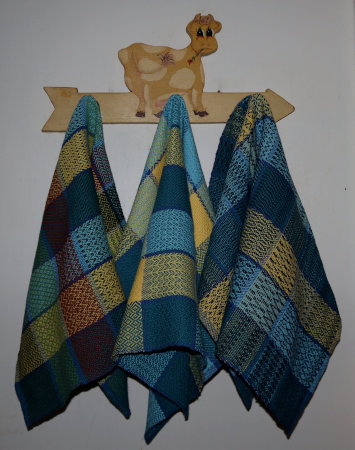Since picking up weaving again (intended!) I've been absorbing weaving websites,
blogs, and videos. The most commonly recommended book I'm seeing is
by Anne Dixon
Seeing that it was published in 2007—two years before I packed up my loom for
14 years—I initially wondered why I didn't have it in my library already,
considering what a bibliophile I am. But the subtitle explains it, "Over 600
weaves for 4-shaft looms." About the time this was published, I was selling my
4-shaft jack loom and weaving exclusively on
my 8-shaft Glimakra. At the time,
I was buying books specifically geared toward 8-shaft weaving.
Now, I'm weaving on a 4-shaft table loom, and have to agree that The Handweaver's Pattern Directory
is a must-have for every 4-shaft weaver.
The book has two main sections: the introduction and the pattern directory.
The introduction starts with what to expect from the book and how to understand the weaving drafts. Next, it discusses basic equipment, fibers, yarns, selvedges, sett, weave structure, calculating warp length, color theory, and sampling. Everything is laid out logically, with plenty of photographs, making this section an excellent reference resource.
The directory is divided into four pattern sections: basic threadings, block drafts, lace weaves, and special threadings, which include things like undulating twills, advancing twills, syncopated threading, turned Monk's Belt threading, distorted weft, supplementary warp, warp face weaves, etc. Each section begins with an introduction and basic explanation, along with tips for weaving that category of patterns. Then comes the eye candy.
The photos are all in color, which gives this book a distinct advantage over the books I've been using for my
sampler and
twill gamp. The interplay of color in the various samples is interesting and helpful. And I think, makes it easier to follow the drafts. For example, the treadling draft uses the weft colors in the piece (rather than just long columns of tiny black squares) so it's easier to follow the changes and keep one's place.
Most pages are set up three samples per, and explore a variety of treadling options (lever lift options for me!) for a particular threading. Some are set up as a two-page spread with three different threadings and three treadling patterns. This is perfect for gamps (
definition here), which are excellent learning projects. In fact, I have my eye on "Crackle," pages 130 to 135.
The book wraps up with a chapter on how to finish handwovens, and includes everything to consider before taking it off the loom (preventing unraveling and uneven shrinkage), hemming, fringes, hemstitching, plus detailed information on wet finishing. Following are a glossary, an index (yay!) and a page of weaving resources. Also noteworthy, it's spiral bound, so the open pages lie flat, and the back flap, which folds out with a quick review of how to read the weaving drafts.
So, yes, highly recommended. Amazingly, I almost didn't buy this book because surely, I don't need more books. But the price on
Amazon was the best I'd seen and I needed to round up an order to get free shipping. Or so I told myself, lol. Anyway, it is now the first book I reach for, and it will be one of my most used weaving books, without a doubt.






















































